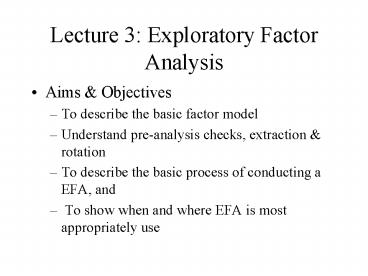Lecture 3: Exploratory Factor Analysis - PowerPoint PPT Presentation
1 / 17
Title:
Lecture 3: Exploratory Factor Analysis
Description:
Understand pre-analysis checks, extraction & rotation ... Create correlation matrix. Extraction. How many factors? Rotation. How to best view the solution ... – PowerPoint PPT presentation
Number of Views:361
Avg rating:3.0/5.0
Title: Lecture 3: Exploratory Factor Analysis
1
Lecture 3 Exploratory Factor Analysis
- Aims Objectives
- To describe the basic factor model
- Understand pre-analysis checks, extraction
rotation - To describe the basic process of conducting a
EFA, and - To show when and where EFA is most appropriately
use
2
Basic principle of EFA
- EFA tries to explain a set of correlations among
variables in terms of a set of smaller common
factors and zero cross loadings
3
Factor analysis of cognitive abilities
- Verbal Reasoning
- Sentence completion
- Comprehension
- Cloze test
- Mathematical Spatial
- Spatial rotation
- Computation
- Find the figure
4
Process
- Pre-analysis
- Collect data of the 6 test
- Sample size, N of items, Social desirability
- Create correlation matrix
- Extraction
- How many factors?
- Rotation
- How to best view the solution
5
Pre-analysis checks I
- Scaling
- Likert-type
- Dichotomous use Phi
- correct
- Item selection
- Theory, a-priori structure (marker variables)
- Sampling
- To the population where the results are to be
generalised
6
Pre-analysis checks II
- Ratios Stable structure
- N (min 100)
- NP (21, 101)
- PM (41)
- NM (61)
- Social desirability
- Remove items correlating with social desirability
7
(No Transcript)
8
Pre-analysis checksIII
Bartlett test of Sphericity
Matrix to be analysed
Identity matrix
V1 1 V2 0 1 V3 0 0 1 V4 0 0 0 1
V1 1 V2 .23 1V3 .31 .25 1 V4 .54 .32 .41 1
KMO greater than .5
9
Communalities
- The shared variance of a variable with a factor
- Initially need to estimate these.
- Largest column r in the diagonal
- SMC
10
Number of factors to extract
Eigenvalues
2
Actual data (eigenvalues)
1
Random eigenvalues
Factors
1
n
11
Rotation simple structure
FI FII FI FII Sentence .65 .34 .78 .14 Compreh
. .59 .28 .67 .09 Cloze .44 .71 .65 .10 Figure
.31 .62 .15 .70 Rotation .45 .65 .10 .78 Coputa
t. .53 .77 .17 .73
12
Rotation - orthogonal
FI(a)
Verbal
Math/spatial
FII
(a)
13
Rotate
FI(a)
Verbal
FI (b)
Math/spatial
FII
(a)
FII (b)
14
Rotation - oblique
FI(a)
FII
(a)
Delta
15
The basic factor model
Common factors
Loading
Verbal
Math/Spatial
Unique factors
Variables
16
Naming and next steps
- Factor naming
- Re-captured Item Technique (RIT)
- Markers
- Raters
- Reliability validity
17
Use abuses of EFA
- Uses
- IQ
- Personality psychometrics
- Education
- Psychophysiology
- Factorial validity
- Data reduction?
- Problems
- Garbage In Garbage Out (GIGO)































